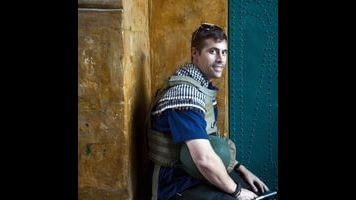The first time James Foley appears on screen in Brian Oakes’ documentary about the late war correspondent, his voice exudes a disarming humility. As he tells an audience at Marquette University about his experiences during the first Libyan civil war, he gives the impression of a man who is wholeheartedly devoted to his work: reporting from the front lines of war-torn areas at great personal cost, trying to glean the human stories underneath the violent images, shining a light on foreign conflicts of which many may only be superficially aware. Perhaps there were more deeply personal, and maybe even somewhat selfish, factors driving Foley. Many of the family members interviewed in Jim: The James Foley Story admit to initially seeing only a restlessness in Foley that verged on recklessness, especially when they discovered he had gone to Libya. But it’s selflessness, not selfishness, that permeates this feature-length documentary portrait.
Foley was decapitated in August 2014, the first American citizen killed by the radical fundamentalists of the Islamic State group, an early indication of just how powerful this jihadist organization was about to become in the Middle East. As indicated by the title’s use of Foley’s nickname, Oakes’ film is an attempt to highlight the human being behind the appalling news story: the ardent, energetic, and above all compassionate journalist and person he was. Jim is divided roughly into two parts. The first is a fairly breezy chronicle of Foley’s upbringing, including his time as an increasingly dissatisfied Teach For America instructor. He was bitten by the foreign-correspondent bug when he was an embedded journalist in Iraq in 2009, and decided to commit his life to journalism through stints in Libya and Syria. The second half of Jim homes in on Foley’s imprisonment in Syria, with many of his fellow prisoners offering anecdotes about his actions, behavior, and overall humane and optimistic spirit.
This second half is by far the film’s riskiest—formally, at least. Certainly, it’s by far the more reenactment-heavy section, with the journalists themselves recounting certain moments of their captivity in Syria often over staged recreations of those episodes; in addition, the backdrops of the interview footage with the various journalists are dimly lit, thereby matching the similarly chiaroscuro nature of the prison reenactments (shot by director of photography Clair Popkin). Perhaps most daring of all, however, is the section’s sheer duration. The audience is meant to experience, to some degree, the grueling length of Foley’s second imprisonment; in such a grim context, the more brightly lit reenactment scenes, combined with reminiscences of Foley’s “social intelligence”—his willingness to give his food to others at the expense of his own appetite, his creation of a board game involving dates to help pass the time, and so on—even in such inhumane circumstances, have a near-oracular visceral effect. In light of the circumstances and the outcome, they offer the only pockets of hope to be found.
It’s during these sequences that Oakes’ film comes perilously close to laying its valorization of Foley on a bit too thick. One of the journalists held captive with Foley calls him a force of “pure good,” but it isn’t necessary to buttress that impression with sentimental twinkling music and lighting that suggests that the almighty is smiling down on Foley. Thankfully, Oakes mostly allows the facts and talking-head remembrances to speak for themselves, without excessive stylistic adornment. Especially useful in that regard are the interviews with some of Foley’s colleagues from his time in Libya and Syria, who illuminate the challenges they face daily in such conflict zones—most poignantly, that helpless sense of running up against the limits of journalistic distance, unable to intervene and help their subjects in troubled times, a limitation Foley tried to transcend in his own ways. Jim: The James Foley Story is more than just a tribute to a fallen journalist. It’s a deeply moving testament to a man who dared to face the worst of humanity and somehow managed to maintain his sense of empathy in spite of it all.

